#In honor of Saint Patrick
Text
Look how pretty ~

#Smoke green#In honor of Saint Patrick#Bongs#Grinders#Glass#Floral#Pink#aesthetic#Flowers#Mushrooms#Spring#Girly#girls who smoke#me#girls#pretty#mine#Weed#420#dollskill
10 notes
·
View notes
Text
#fall out boy#fob#pete wentz#patrick stump#andrew hurley#joseph trohman#joe trohman#andy hurley#honorable mention is an honorable mention#and patron saint of liars and fakes#i miss their ridiculous song titles
844 notes
·
View notes
Text
finding myself tip toeing back to Catholicism and I have mixed feelings
#Like idk how i feel#growing up catholic definitely influenced me a lot#even if i'm not religious now#And if i were to be christian it would have to be catholic#bc Mary's perpetual virginity is non-negotiable#sorry not sorry#rn i'm just fixated on the Catholic aesthetic and convincing myself that's all#I'm buying so many crosses/crucifixes/miraculous medals#and thinking about all the saints I honored as a kid#st bernadette#st Catherine#st joan of arc#st francis of assisi#st Patrick#st jude#st Valentine#mary magdalene#st lucy
4 notes
·
View notes
Text
Pentiment's Complete Bibliography, with links to some hard-to-find items:
I've seen some people post screenshots of the game's bibliography, but I hadn't found a plain text version (which would be much easier to work from), so I put together a complete typed version - citation style irregularities included lol. I checked through the full list and found that only four of the forty sources can't be found easily through a search engine. One has no English translation and I'm not even close to fluent enough in German to be able to actually translate an academic article, so I can't help there. For the other three (a museum exhibit book, a master's thesis, and portions of a primary source that has not been entirely translated into English), I tracked down links to them, which are included with their entries on the list.
If you want to read one of the journal articles but can't access it due to paywalls, try out 12ft.io or the unpaywall browser extension (works on Firefox and most chromium browsers). If there's something you have interest in reading but can't track down, let me know, and I can try to help! I'm pretty good at finding things lmao
Okay, happy reading, love you bye
Beach, Alison I. Women as Scribes: Book Production and Monastic Reform in Twelfth-Century Bavaria. Cambridge Univeristy Press, 2004.
Berger, Jutta Maria. Die Geschichterder Gastfreundschaft im hochmittel alterlichen Monchtum: die Cistercienser. Akademie Verlag GmbH, 1999. [No translation found.]
Blickle, Peter. The Revolution of 1525. Translated by Thomas A. Brady, Jr. and H.C. Erik Midelfort. The Johns Hopkins University Press, 1985.
Brady, Thomas A., Jr. “Imperial Destinies: A New Biography of the Emperor Maximilian I.” The Journal of Modern History, vol 62, no. 2., 1990. pp.298-314.
Brandl, Rainer. “Art or Craft: Art and the Artist in Medieval Nuremberg.” Gothic and Renaissance Art in Nuremberg 1300-1550. The Metropolitan Museum of Art, 1986. [LINK]
Byars, Jana L., “Prostitutes and Prostitution in Late Medieval Bercelona.” Masters Theses. Western Michigan University, 1997. [LINK]
Cashion, Debra Taylor. “The Art of Nikolaus Glockendon: Imitation and Originality in the Art of Renaissance Germany.” Journal of Historians of Netherlandish Art, vol 2, no. 1-2, 2010.
de Hamel, Christopher. A History of Illuminated Manuscripts. Phaidon Press Limited, 1986.
Eco, Umberto. The Name of the Rose. Translated by William Weaver. Mariner Books, 2014.
Eco, Umberto. Baudolino. Translated by William Weaver. Mariner Books, 2003.
Fournier, Jacques. “The Inquisition Records of Jacques Fournier.” Translated by Nancy P. Stork. Jan Jose Univeristy, 2020. [LINK]
Geary, Patrick. “Humiliation of Saints.” In Saints and their cults: studies in religious sociology, folklore, and history. Edited by Stephen Wilson. Cambridge University Press, 1985. pp. 123-140
Harrington, Joel F. The Faithrul Executioner: Life and Death, Honor and Shame in the Turbulent Sixteenth Century. Farrar, Straus and Giroux, 2013.
Hertzka, Gottfired and Wighard Strehlow. Grosse Hildegard-Apotheke. Christiana-Verlag, 2017.
Hildegard von Bingen. Physica. Edited by Reiner Hildebrandt and Thomas Gloning. De Gruyter, 2010.
Julian of Norwich. Revelations of Divine Love. Translated by Barry Windeatt. Oxford Univeristy Press, 2015.
Karras, Ruth Mazo. Sexuality in Medieval Europe: Doing Unto Others. Routledge, 2017.
Kerr, Julie. Monastic Hospitality: The Benedictines in England, c.1070-c.1250. Boudell Press, 2007.
Kieckhefer, Richard. Forbidden rites: a necromancer’s manual of the fifteenth century. Sutton, 1997.
Kuemin, Beat and B. Ann Tlusty, The World of the Tavern: Public Houses in Early Modern Europe. Routledge, 2017.
Ilner, Thomas, et al. The Economy of Duerrnberg-Bei-Hallein: An Iron Age Salt-mining Center in the Austrian Alps. The Antiquaries Journal, vol 83, 2003. pp. 123-194
Lang, Benedek. Unlocked Books: Manuscripts of Learned Magic in the Medieval Libraries of Central Europe. The Pennsylvania State University Press, 2008
Lindeman, Mary. Medicine and Society in Early Modern Europe. Cambridge University Press, 2019.
Lowe, Kate. “’Representing’ Africa: Ambassadors and Princes from Christian Africa to Renaissance Italy and Portugal, 1402-1608.” Transactions of the Royal Historical Society Sixth Series, vol 17, 2007. pp. 101-128
Meyers, David. “Ritual, Confession, and Religion in Sixteenth-Century Germany.” Archiv fuer Reformationsgenshichte, vol. 89, 1998. pp. 125-143.
Murat, Zuleika. “Wall paintings through the ages: the medieval period (Italy, twelfth to fifteenth century).” Archaeological and Anthropological Sciences, vol 23, no. 191. Springer, October 2021. pp. 1-27.
Overty, Joanne Filippone. “The Cost of Doing Scribal Business: Prices of Manuscript Books in England, 1300-1483.” Book History 11, 2008. pp. 1-32.
Page, Sophie. Magic in the Cloister: Pious Motives, Illicit Interests, and Occullt Approaches to the Medieval Universe. The Pennsylvania State University Press, 2013.
Park, Katharine. “The Criminal and the Saintly Body: Autopsy and Dissectionin Renaissance Italy.” Renaissance Quarterly, vol 47, no. 1, Spring 1994. pp. 1-33.
Rebel, Hermann. Peasant Classes: The Bureaucratization of Property and Family Relations under Early Habsburg Absolutism, 1511-1636. Princeton University Press, 1983.
Rublack, Ulinka. “Pregnancy, Childbirth, and the Female Body in Early Modern Germany.” Past & Present,vol. 150, no. 1, February 1996.
Salvador, Matteo. “The Ethiopian Age of Exploration: Prester John’s Discovery of Europe, 1306-1458.” Journal of World History, vol. 21, no. 4, 2011. pp.593-627.
Sangster, Alan. “The Earliest Known Treatise on Double Entry Bookkeeping by Marino de Raphaeli.” The Accounting Historians Journal, vol. 42, no. 2, 2015. pp. 1-33.
Throop, Priscilla. Hildegarde von Bingen’s Physica: The Complete English Translation of Her Classic Work on Health and Healing. Healing Arts Press, 1998.
Usher, Abbott Payson. “The Origins of Banking: The Brimitive Bank of Deposit, 1200-1600.” The Economic History Review, vol. 4, no. 4. 1934. pp.399-428.
Waldman, Louis A. “Commissioning Art in Florence for Matthias Corvinus: The Painter and Agent Alexander Formoser and his Sons, Jacopo and Raffaello del Tedesco.” Italy and Hungary: Humanism and Art in the Early Renaissance. Edited by Peter Farbaky and Louis A. Waldman, Villa I Tatti, 2011. pp.427-501.
Wendt, Ulrich. Kultur and Jagd: ein Birschgang durch die Geschichte. G. Reimer, 1907.
Whelan, Mark. “Taxes, Wagenburgs and a Nightingale: The Imperial Abbey of Ellwangen and the Hussite Wars, 1427-1435.” The Journal of Ecclesiastical History, vol. 72, no. 4, 2021, pp.751-777.
Wiesner-Hanks, Merry E. Women and Gender in Early Modern Europe. Cambridge University Press, 2008.
Yardeni, Ada. The Book of Hebrew Script: History, Palaeography, Script Styles, Calligraphy & Design. Tyndale House Publishers, 2010.
308 notes
·
View notes
Note
AGSZC learn about the fact you can pinch people if they aren’t wearing Green on March 17th. (Whether or not they know why would depend on if they have an equivalent of saints in their world)
How does the chaos unfold? Who pranks another first?
*It starts when Reno sees Sephiroth minding his own business, not wearing green. He decides to try his luck, walks up behind him and pinches his side*
Sephiroth: Why are you pinching me?
Reno: You're not wearing green. It's St. Patrick's day. You're allowed to pinch people who aren't wearing green on St. Patrick's day.
Sephiroth: I had no idea.
Reno: Yeah, it's how you celebrate.
Sephiroth: You mean to say that if someone isn't adhering to the rules of March 17th and wearing the color green, you must punish them physically for disrespecting St. Patrick.
Reno:
Sephiroth:
Reno: This is why I don't talk to you people.
-
*Cloud is coming back from an assignment when Sephiroth appears out of nowhere—wearing a green shirt—and starts thwacking him with a broomstick*
Cloud: ACK.
Sephiroth: You're not wearing green. You have disgraced us all.
Cloud, confused: But sir—ow! My scarf—ow! My scarf is green!
*Sephiroth checks his uniform scarf, which is indeed green*
Sephiroth:
Cloud:
Sephiroth: No one will ever believe you.
*Sephiroth walks away with the broomstick*
-
*Angeal sits on a couch in the SOLDIER lounge after a hard day. He settles down with a copy of his favorite gardening magazine and a sandwich*
Angeal: Lazard had a point. I never take time off for myself. Why do I feel so guilty? It's not like a malicious, punishing hand will appear whenever I try to relax.
*Sephiroth pops up from behind the couch and starts choking Angeal*
Angeal: !
Sephiroth: There is nothing honorable about refusing to wear green on St. Patrick's day.
Angeal: !?
Sephiroth: You sicken me.
-
*Zack is whistling as he pushes open the door to the showers*
....
*Zack runs back out screaming. Sephiroth chases after him with a flamethrower*
Sephiroth: WHY WON'T ANYONE WEAR GREEN?
-
*Genesis steps off the elevator, Sephiroth is standing there with a bucket of green paint to throw at him*
Genesis: Ah-ah!
*Genesis points at his green earring*
Sephiroth:
Genesis: You thought I wouldn't be prepared, didn't you? You underestimated me, thinking me a fool, a careless heathen who would be bested by you once more.
Sephiroth:
Genesis: How does it feel to be wrong? Will this sensation suffice to keep you warm tonight, or must you burn your last bit of dignity too?
Sephiroth:
Genesis: I've waited for this blessed day ever since I made your acquaintance. I've been patient. The wait was long and arduous but I knew it would come.
Sephiroth:
Genesis: And now that we're here, I must say, it was well worth it. I win, Sephiroth. But please, don't let the light of glory that bathes my body blind you.
Sephiroth:
Sephiroth: You idiot. That's not even green, it's teal.
*Sephiroth throws the bucket of paint at him*
#ff7#ffvii#final fantasy 7#sephiroth#final fantasy vii#ffvii crisis core#genesis rhapsodos#ff7 crisis core#angeal hewley#zack fair#cloud strife#storytime
105 notes
·
View notes
Text
Important Facts about Lughnasadh from an Irish Celtic Reconstructionist
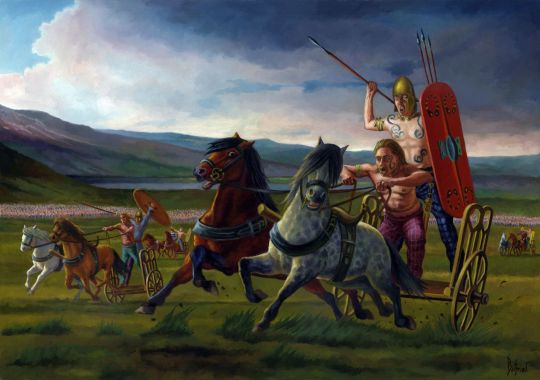

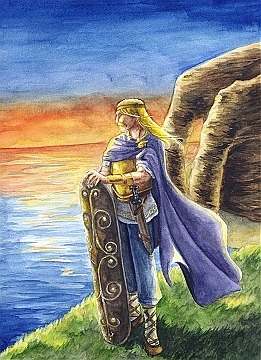
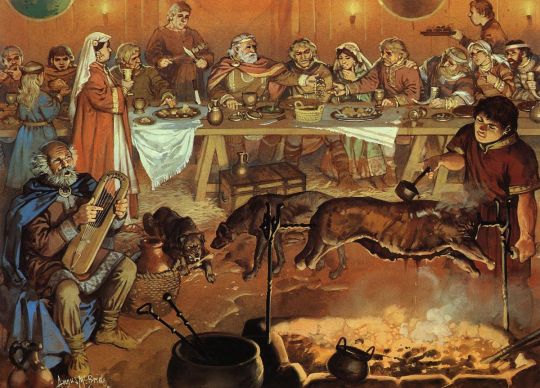
Spelling and Pronunciation
OI. Lughnasadh (Loo-na-sa), sometimes spelled Lughnasa or Modern Irish Lúnasa. Not to be confused with other harvest festivals like Lammas.
Dates
Most reconstructionists celebrate Lughnasadh on July 31st - August 1st from sundown to sundown by the Gregorian calendar, while others choose to celebrate the transitional period between the months as they would have been by the Julian calendar (about 13 days later by the Gregorian calendar).
Traditionally this festival likely would have happened as the grains were ready for harvesting or possibly even when the wild bilberries were ripe (as some scholars mention that if the grains were not ripe they would still preform a ritualized ‘first harvesting’ but it is possible this tradition came after the festival was firmly tied to a calendar date.)
Importance in the Mythos
In the mythologies it is well documented that this festival coincides with Lugh’s funeral games in honor of his foster-mother Tailtiu, known as Aonach Tailteann. In the mythologies she is said to have died of exhaustion after clearing the plains of Ireland for agricultural needs. The first documented instance of Lughnasadh in the mythologies was in the Wooing of Emer, Tochmarc Emire, which makes sense given the importance of marriages at this time of the year. It is not known specifically but widely speculated that the curse of the Ulstermen by Macha took place at a horse race for this festival.
In later time periods it is common to see a form of struggle, normally between the ‘protective’ forces and ‘destructive’ forces. The modern equivalent being the struggle between Saint Patrick and Crom Dubh but this is likely a reflection of an early struggle between Lugh and Balor (which I previously mentioned in my info-dump on Bealtaine).
Celebration Traditions
Aonachs, funeral games, have (to the best of our knowledge) been a custom in Ireland since the bronze age and were practiced on and off into the middle ages. They had both personal and community functions and occurred in three stages. Stage one was the funeral proceedings themselves. They would last one to three days, likely depending on the importance of the individual in question. Mourning songs and chants were participated in by both the attendees and the Druids. The second stage was for proclaiming of laws. Aonachs were a time when universal peace between túaths was declared. The third stage was that of Cuiteach Fuait, games that tested mental and physical abilities. These games included the well known horse and chariot races, wrestling games, boxing, high jumps but also competitions in strategy, singing, story telling and between various skilled craftsmen.
It was incredibly common for marriages to be arranged and preformed during this festival. More well known ‘trial marriages’ (lasting a year and a day) were still preformed at this festival up until the 13th century. It is likely that the coupling occurring at this time of year had an effect on the relationship to births seen at Imbolg (which falls 9 months later).
MacNeill, a leading scholarly expert on the festival, notes that a ritualistic bull sacrifice was made at this festival and the bull would then be eaten. I could not find any definitive evidence to support the idea, but I think it was likely that bulls in general would be culled from the herd at this point in the year to supply the feast.
Art credit @ire-ethereal
#irish#irish mythology#celtic#irish paganism#irish polytheism#paganism#celtic paganism#celtic polytheism#pagan#celtic reconstructionist#celtic reconstructionism#celtic mythology#irish reconstructionism#irish reconstructionist#festival#fire festival#lugh#lughnasadh#Lughnasa#NOT lammas#Tailtiu#harvest#blackcrowing
262 notes
·
View notes
Text

I typed up the Pentiment bibliography for my own use and thought I’d share it here too. In case anyone else is fixated enough on this game to embark on some light extra-curricular reading
I haven’t searched for every one of these books but a fair few can be found via one of the following: JSTOR / archive.org / pdfdrive.com / libgen + libgen.rocks; or respective websites for the journal articles.
List below the cut!
Beach, Alison I, Women as Scribes: Book Production and Monastic Reform in Twelfth-Century Bavaria. Cambridge University Press, 2004
Berger, Jutta Maria. Die Geschichte der Gastfreundschaft im hochmittelalterlichen Mönchtum die Cistercienser. Akademie Verlag GmbH, 1999
Blickle, Peter. The Revolution of 1525. Translated by Thomas A. Brady, Jr. and H.C. Erik Midelfort. The Johns Hopkins University Press, 1985
Brady, Thomas A., Jr. “Imperial Destinies: A New Biography of the Emperor Maximilian I.” The Journal of Modern History, vol.62, no.2, 1990. pp. 298-314
Brandl, Rainer. “Art or Craft? Art and the Artist in Medieval Nuremberg.” Gothic and Renaissance Art in Nuremberg 1300-2550. The Metropolitan Museum of Art, 1986
Byars, Jana L., “Prostitutes and Prostitution in Late Medieval Barcelona.” Masters Theses. Western Michigan University, 1997
Cashion, Debra Taylor. “The Art of Nikolaus Glockendon: Imitation and Originality in the Art of Renaissance Germany.” Journal of Historians of Netherlandish Art, vol.2, no.1-2, 2010
de Hamel, Christopher. A History of Illuminated Manuscripts. Phaidon Press Limited, 1986
Eco, Umberto. The Name of the Rose. Translated by William Weaver. Mariner Books, 2014
Eco, Umberto. Baudolino. Translated by William Weave. Boston, Mariner Books, 2003
Fournier, Jacques. “The Inquisition Records of Jacques Fournier.” Translated by Nancy P. Stork, San Jose University, 2020
Geary, Patrick. “Humiliation of Saints.” In Saints and their cults: studies in religious sociology, folklore, and history. Edited by Stephen Wilson. Cambridge University Press, 1985. pp. 123-140
Harrington, Joel F. The Faithful Executioner: Life and Death, Honor and Shame in the Turbulent Sixteenth Century. Farrar, Straus and Giroux, 2013
Hertzka, Gottfied and Wighard Strehlow. Große Hildegard-Apotheke. Christiana-Verlag, 2017
Hildegard von Bingen. Physica. Edited by Reiner Hildebrandt and Thomas Gloning. De Gruyter, 2010
Julian of Norwich. Revelations of Divine Love. Translated by Barry Windeatt. Oxford University Press, 2015
Karras, Ruth Mazo. Sexuality in Medieval Europe: Doing Unto Others. Routledge, 2017
Kerr, Julie. Monastic Hospitality: The Benedictines in England, c.1070-c.1250. Boydell Press, 2007
Kieckhefer, Richard. Forbidden rites: a necromancer's manual of the fifteenth century. Sutton, 1997
Kümin, Beat and B. Ann Tlusty. The World of the Tavern: Public Houses in Early Modern Europe. Routledge, 2017
Ilner, Thomas, et al. The Economy of Dürnberg-Bei-Hallein: an Iron Age Salt-mining Centre in the Austrian Alps. The Antiquaries Journal, vol. 83, 2003. pp. 123-194
Làng, Benedek. Unlocked Books: Manuscripts of Learned Magic in the Medieval Libraries of Central Europe. The Pennsylvania State University Press, 2008
Lindeman, Mary. Medicine and Society in Early Modern Europe. Cambridge University Press, 2010
Lowe, Kate. “'Representing' Africa: Ambassadors and Princes from Christian Africa to Renaissance Italy and Portugal, 1402-1608.” Transactions of the Royal Historical Society Sixth Series, vol. 17, pp. 101-128
Meyers, David. “Ritual, Confession, and Religion in Sixteenth-Century Germany.” Archiv für Reformationsgeschichte, vol. 89, 1998. pp. 125-143
Murat, Zuleika. “Wall paintings through the ages: the medieval period (Italy, twelfth to fifteenth century).” Archaeological and Anthropological Sciences, vol. 12, no. 191. Springer, October 2021. pp. 1-27
Overty, Joanne Filippone. “The Cost of Doing Scribal Business: Prices of Manuscript Books in England, 1300-1483.” Book History 11, 2008. pp. 1-32
Page, Sophie. Magic in the Cloister: Pious Motives, Illicit Interests and Occult Approaches to the Medieval Universe. The Pennsylvania State University Press, 2013
Park, Katharine. “The Criminal and the Saintly Body: Autopsy and Dissection in Renaissance Italy.” Renaissance Quarterly, vol. 47, no. 1, Spring 1994. pp. 1-33
Rebel, Hermann. Peasant Classes: The Bureaucratization of Property and Family Relations under Early Habsburg Absolutism, 1511-1636. Princeton University Press, 1983
Rublack, Ulinka. “Pregnancy, Childbirth, and the Female Body in Early Modern Germany.” Past & Present, vol. 150, no. 1, February 1996. pp. 84-110
Salvadore, Matteo. “The Ethiopian Age of Exploration: Prester John's Discovery of Europe, 1306-1458.” Journal of World History, vol. 21, no. 4, 2011. pp. 593 - 627
Sangster, Alan. “The Earliest Known Treatise on Double Entry Bookkeeping by Marino de Raphaeli”. The Accounting Historians Journal, vol. 42, no. 2, 2015. pp. 1-33.
Throop, Priscilla. Hildegard von Bingen's Physica: The Complete English Translation of Her Classic Work on Health and Healing. Healing Arts Press, 1998
Usher, Abbott Payson. “The Origins of Banking: The Primitive Bank of Deposit, 1200-1600.” The Economic History Review, vol. 4, no. 4, 1934. pp. 399-428
Waldman, Louis A. “Commissioning Art in Florence for Matthias Corvinus: The Painter and Agent Alexander Formoser and his Sons, Jacopo and Raffaello del Tedesco.” Italy and Hungary: Humanism and Art in the Early Renaissance. Edited by Péter Farbaky and Louis A. Waldman, Villa I Tatti, 2011. pp. 427-501
Wendt, Ulrich. Kultur und Jagd: ein Birschgang durch die Geschichte. G. Reimer, 1907
Whelan, Mark. “Taxes, Wagenburgs and a Nightingale: The Imperial Abbey of Ellwangen and the Hussite Wars, 1427-1435.” The Journal of Ecclesiastical History, vol. 72, no. 4, 2021, pp. 751-777.e
Wiesner-Hanks, Merry E. Women and Gender in Early Modern Europe. Cambridge University Press, 2008
Yardeni, Ada. The Book of Hebrew Script: History, Paleography, Script Styles, Calligraphy & Design. Tyndale House Publishers, 2010
#pentiment#Pentiment bibliography#some of these books give me strong first-year undergrad vibes#even just seeing ulinka rublack’s name gives me semi-traumatic flashbacks to cultural history seminars#would I cope better with it now that I don’t have to write essays each week on the topic?#¯\_ (ツ)_/¯#probs not tbh#also it probably would have been a lot faster if I could have pulled this list from game files somehow#but I do not know how to do that :)))#Anyway I hope this is of use to somebody at some point#I wish you all a very happy reading about the primitive deposit banking system everybody 😌
762 notes
·
View notes
Text
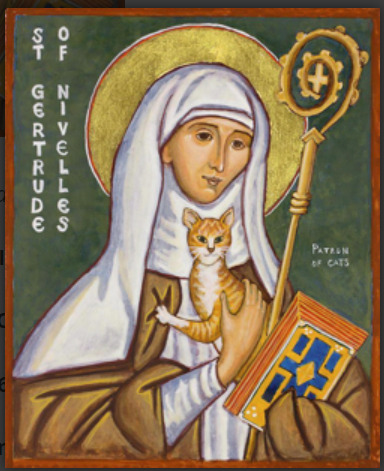
History of St. Gertrude: The Patron Saint of Cats
St. Gertrude of Nivelles’ patronage was never made official by the Vatican, but her association with whisking away mice and rats made her, by default, the saint that all cat lovers worshipped. While modern media has associated her with cats in most portrayals, there’s a lot more to the patron saint of cats than just being deemed the cat lady of the Catholic church.
According to history records, St. Gertrude was born in the city of Nivelles in 626, which we now know as modern-day Belgium. As the youngest child of four, St. Gertrude was meant to follow in the footsteps of her eldest sister Pepin when it came to agreeing to an arranged marriage. Devoted to her faith and with the help of her mother, St. Gertrude escaped the bindings of having to agree to an arrangement by opening a separate female-only monastery. Here, she devoted herself to her faith until she left the monastery to tend to those in need.
Most claim her association with cats stems from a feline’s predatory instinct to catch and chase away rodents. During her time serving in her city, St. Gertrude was frequently summoned by the townsfolk to ward off illness and rodent infestations. People swore by her energy to chase away anything disease-ridden, and ultimately this is why she was canonized after she passed away on March 17 at age 33. Many churches were built in her memory, and many claims of miracles have happened at her hands.
In remembrance of her, many Catholic people also celebrate St. Gertrude’s feast day on March 17 alongside St. Patrick’s Day. Each fall, Nivelles holds Le Tour Sainte-Gertrude, a parade around the city that draws many pilgrims and features a mass in honor of St. Gertrude. When you’re donning your favorite green gear for the lucky holiday, give your furry friend an extra pet in honor of our favorite cat lady!
If you want to donate:
Ko-fi.com/goodlifecatsanctuary
we always need food and cat litter and other supplies.! Thanks
we also have an Amazon Wish List: https://www.amazon.com/hz/wishlist/ls/2656NCWR1XQD7?ref_=wl_share
166 notes
·
View notes
Text
DIAS Black Friday Sale
Once a year, the Dublin Institute for Advanced Studies (DIAS), offers a sale for Black Friday -- DIAS is one of the major publishers for Celtic Studies, many of the best studies of medieval Irish material have come through there.
Some books that I recommend, personally:
Fergus Kelly, A Guide to Early Irish Law (26.25 Euro, normally 35) (THE introduction to law in medieval Ireland)
"", Early Irish Farming (26.25 Euro, normally 35) (Everything you wanted to know about day to day life in medieval Ireland but were afraid to ask. Literally. Everything.)
Medieval Irish Prose
Fergus Kelly, Audacht Morainn (18.75 Euro, normally 25)
Are you planning on becoming a medieval Irish king? Do you want to know what you should do to involve the total destruction of the natural order? Then this is the text for you! Now with English translation!
In all seriousness, this text is used a LOT with regards to studies of ideal kingship in medieval Ireland.
Cecile O'Rahilly, The Táin from the Book of Leinster (26.25 Euro, usually 35)
I'll be real with you, lads: I hate Cú Chulainn. I hate him. I hate his smug, misogynistic face. His creepy multi-pupiled eyes. The shitty way he treats Emer. The way that his presence is like this black hole in the study of medieval Irish literature that means that the Ulster Cycle can get a prestigious yearly conference held in its honor while the other cycles are left with either crumbs or outright dismissal. I think the Táin is boring and episodic as a piece of lit and I've never found anything overly redeeming about it over any other piece of medieval Irish literature, especially since imo other pieces of literature do women (and homoeroticism) much better and get much less praise for it.
...that being said. It's important. It IS iconic, both as a piece of medieval Irish literature and, in general, to Irish literature. Its status as The Irish Iliad means that, if you want to study medieval Irish stuff...you have to read the Táin. And this is a version of the Táin that you might not have gotten, translated and edited by a master of Old Irish, with commentary.
"", Táin Bó Cúailnge: recension I (10 Euro, normally 35)
See above.
Early Irish History and Genealogy
T.F. O'Rahilly, Early Irish History and Genealogy (30 Euro, normally 40)
So. On the record, a lot of what he says here is absolutely not currently believed in the field. Just. No. BUT. There's a reason why I always recommend him anyway, and it's because if you're serious about doing a study of Irish Mythology, whatever we take that to mean...you will not be able to avoid this man. His ideas were very popular for decades and still often are to people who don't really focus on mythology. It's better to know where these ideas come from and to identify them than not, and O'Rahilly, in his defense, had an *excellent* knowledge of his sources. It's dense, it's difficult (rather like the author himself, from the accounts I've heard), but it's necessary if you really want to attack this.
Joan Radner, Fragmentary Annals of Ireland (22.50, normally 30)
There is so much weird shit in the Fragmentary Annals. So much.
Welsh
Patrick Sims Williams, Buchedd Beuno: The Middle Welsh Life of St Beuno (22.50 Euro, normally 30)
I know what you're thinking: "Why the FUCK are they recommending this book about a random Welsh saint? Answer: Because this is how I learned Middle Welsh. The introduction to Welsh at the front of the book + the VERY good index at the back is still one of the best ways to learn Middle Welsh. Also if anyone was watching the Green Knight film and going "Why is there a lady with her head chopped off?" this answers that question.
R. L. Thomson, Pwyll Pendeuic Dyuet: the first of the Four Branches of the Mabinogi, edited from the White Book of Rhydderch, with variants from the Red Book of Hergest (15 Euro, normally 20)
Once you've gotten enough of a hang of Middle Welsh to know the basics, it's time to dive into the classics, and what better way to do it than with the Mabinogi, starting at the very beginning, with the First Branch? Personally, I dislike a lot of Thomson's orthographic decisions, but, hey, it's the First Branch, and that's Middle Welsh orthography for you.
Ian Hughes, Math uab Mathonwy (22.50 Euro, normally 30)
The Fourth Branch, my beloved. Incest, rape, bestiality (well...pseudo bestiality, really), creating a new life while not being willing to deal with the consequences of it...it truly has it all. Not for the faint of heart, but absolutely worth the read if you can stomach it because imo it handles its themes very well and it's incredibly haunting.
And a lot more -- go in, shop around, see what's available. Even with the older books, they're often things that we're still referencing in some way into the present.
49 notes
·
View notes
Text
I headcanon that Susie Haltmann sometimes dyes her hair color.
Pink is what she mainly sticks with, as that's her default. But there are occasions where she'll decide to dye it a different color temporarily until she turns it back to pink later.
Other colors that she's dyed her hair to include: purple, green, blue, yellow, red, orange, brown and black.
Yes, she's dyed it many different colors! Susie is a decorative person that loves to try out many different styles and fashions.
Purple is her second main after pink. This is because purple is actually Susie's natural hair color (matches her dad). Pink became her favorite color at the age of 4, and that's when her dad dyed her hair pink as that's become her default hair color since.
But despite pink being Susie's main, she sometimes decides to dye it purple and have it stick for a few days until she goes right back to pink. She does it to honor her dad sometimes.
She dyes her hair green on Saint Patrick's Day every year.
Blue, yellow and red? Bruh, those are the mage sisters' hair colors! It's okay lol. Susie has received their permission to do it on occasion.
Catch her being blue-haired and doing gun stuff with Francisca. Or catch her being red-haired and engaging in trolling matches with Flamberge. Or catch her being yellow-haired and teaming up with Zan to make fun of people on the internet.
Also hilarious that red is one of the hair colors that I headcanon Susie sometimes dying it to, because Parallel Susie has that LOL.
Orange, brown and black are just other colors that Susie decides to occasionally resort to. What can she say? She tries out many options!
How do Susie's friends react to her various different hair colors?
Taranza sincerely compliments her every time, as he well and truly believes she looks beautiful in any hair color. Kirby gets surprised each time he encounters her hair color being different, but still cheers to be supportive. Magolor has found jokes to tell about every single different hair color she's done, as that's his way of being her friend. The mage sisters enjoy it all too.
Don't be surprised if there's comical discussions when the mages catch her hair color being one of theirs. Especially with Flamberge. Susie's dynamic with Flamberge is pretty similar to her dynamic with Magolor: the two love trolling each other for enrichment.
Anyways, yeah, that basically sums up this little headcanon. You're still going to see Susie in her usual pink hair most of the time, but she's a girl of various styles.
She doesn't tell her friends in advance when she dyes her hair color, so she catches them by surprise when they see her hair dyed. Although they already know some of her patterns at this point, including Saint Patrick's Day where her hair's gonna be green.
That's it! Thanks for reading.
#kirby#susie haltmann#susie kirby#kirby susie#susanna patrya haltmann#kirby planet robobot#kirby star allies#parallel susie#taranza#magolor
18 notes
·
View notes
Text

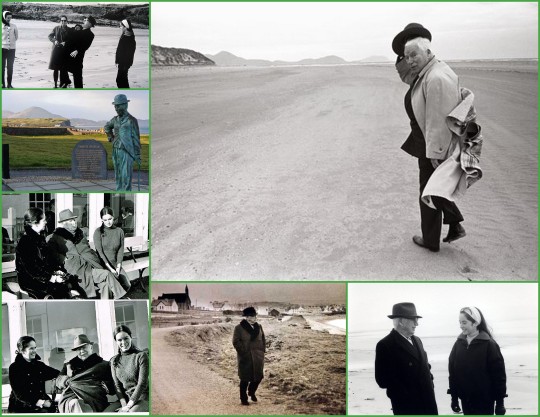
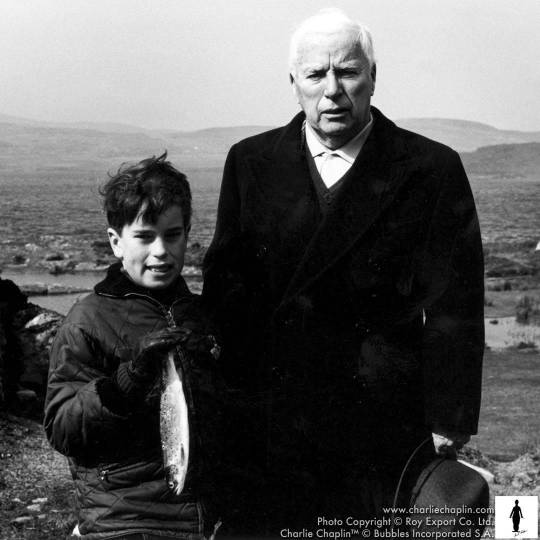
In honor the patron saint of Ireland Happy St. Patrick’s Day or in the Irish language “Lá fhéile Pádraig sona dhuit”
Charlie Chaplin in Waterville, County Kerry, Ireland circa 1965
Charlie, wife Oona and their family spent a great many summers in Southwest Ireland.
His maternal grandfather was from County Cork, Ireland. Charles Frederick Hill - born April 16th 1839, 50 years later, to the day, his grandson Charlie was born - April 16th 1889.
The website - “Charlie Chaplin in Waterville” has some wonderful photos of Charlie and his family and their summers spent there. (x)
13 notes
·
View notes
Text
In honor of the saint Patrick
Some Irish actors and actresses










#saint patricks day#irish#actor#actress#movies#tv series#cillian murphy#collin farrell#andrew scott#liam neeson#paul mescal#michael fassbender#caitriona balfe#saoirse ronan#jonathan rhys meyers
14 notes
·
View notes
Text
Saint Patrick's Day vs. All Snakes Day

Happy All Snakes Day everyone! Sorry it's been a while since I've been active here, research to make sure everything is clear, concise, and accurate is a bit of a bitch sometimes! Plus the all consuming adult world that is work, healthcare, etc.
Saint Patrick's Day celebrates not getting righteously hammed like it does today, but Saint Patrick driving all the 'snakes' from Ireland. All the druids, pagan worshippers, people who basically weren't Christian. According to legend, the patron saint of Ireland 'chased the slithering reptiles into the sea after they began attacking him during a 40-day fast he undertook on top of a hill.' but that's rather contrarian to the evidence. Research suggests snakes never occupied the Emerald Isle in the first place. There are no signs of snakes in the country’s fossil record. And water has surrounded Ireland since the last glacial period. Before that, the region was covered in ice and would have been too cold for the reptiles.
So why celebrate a day about stomping out our practices, even if you only celebrate it to get hammered? All Snakes Day sounds cooler, and better honors the history of paganism by remembering what we've been through, raising a glass to those who lost their lives in the Christianization of the UK and Ireland. So with that in mind, go honor those who came before and get smashed in THEIR honor instead, so long as you can legally drink.
Blessed Ostara (March 19th in the Northern Hemisphere), and good health to you all!
- Blackbird
17 notes
·
View notes
Text
Sunday, 17 March 2024
In honor of Saint Patrick's Day, I would like to offer you lot one of my favorite Irish blessings:
"May you be in heaven half an hour before the Devil knows you're dead!"
16 notes
·
View notes
Text

BoCo The Diesel Engine (Teen Titans Go! Style)
This is another drawing of Thomas characters in Teen Titans Go! Art style, this time it's BoCo. And yes this is also something I did in honor of #Saint Patrick's Day 2024
#mrhowardtheduck2016#dc comics#warner bros animation#BoCo the diesel engine#pbs kids#thomas and friends#saint patricks day 2024#saint patricks day#hit entertainment
9 notes
·
View notes
Text

Today, on his 61st birthday, it is a great honor to pay respect to the tireless Patrick Loch Otieno (P.L.O.) Lumumba.
P.L.O. Lumumba is the preeminent Pan-African today, an example for every man, not just African. A role model to many, including myself, his instinct is United Africa, African solutions to African problems. His instinct is justice and an honest approach to fight corruption. (😉)
A lawer, a gifted speaker, he clearly, slowly, and convincingly presents his case. His speeches are moving, if you have not seen any, please do! ( the 2015 PAVA forum in Uganda is a great one)
His vision of Unification is beautiful, one of morality, justice, and self sufficiency. The idea, the plan for a Unified Africa, the ideals of Pan-Africanism he adresses, should be stamped on the hearts of all mankind, not just Africans. It will take a sustained effort, self-awareness, and a lot of hard work.
Founder of the PLO Lumumba Foundation, The Association of the Citizens Against Corruption, and Movement for Dialog and Non-Violence, PLO Lumumba backs up his words with positive action.
He carries the torch of the greats: Kwame Nkrumah, Patrice Lumumba, and Thomas Sankara. Who is his equal as a Pan-African? Is there anyone alive today who is as synonymous with Africa United?
It's true when it is said "One's name remains above the grave" and "It is possible to kill a man, but it is impossible to kill his name." Patrick Loch Otieno Lumumba has lived up to his namesake, and that was a nearly impossible feat.
* * * * * * *
"The tragedy of Africa is that Africans are in the business of cannonizing thieves and demonizing its saints."
"You can't elect hyenas and expect them to take care of the goats."
- from 2015 PAVA forum in Uganda.
29 notes
·
View notes